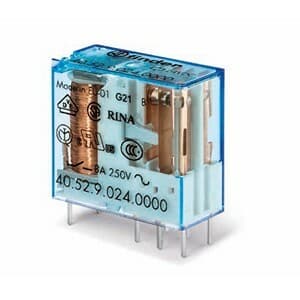| 34.51.7.024.0010 Finder 34.51.7.024.0010 is a relay with a solder pin connection type, designed f... | Finder | | | |
| 55.32.9.024.0080 Finder 55.32.9.024.0080 is a relay with solder pin connection type, designed for... | Finder | | | |
| 39.01.0.024.0060 Finder 39.01.0.024.0060 is a relay with a spring / push-in connection type, desi... | Finder | | | |
| 38.52.7.024.0050 Finder 38.52.7.024.0050 is a relay with a box-clamp connection type, designed fo... | Finder | | | |
| 56.34.9.024.0040 Finder 56.34.9.024.0040 is a relay with a connection type of Fast-on 187, design... | Finder | | | |
| 97.01SPA Finder 97.01SPA is a socket designed for DIN rail mounting with a box-clamp conn... | Finder | | | |
| 38.81.7.024.9024 Finder 38.81.7.024.9024 is a Solid State Relay (SSR) designed with a single Norm... | Finder | | | |
| 38.51.7.024.0050 Finder 38.51.7.024.0050 is a relay with a box-clamp connection type, designed fo... | Finder | | | |
| 40.52.9.024.0000 Finder 40.52.9.024.0000 is a relay with solder pin connection type, designed for... | Finder | | | |
| 40.52.8.024.0000 Finder 40.52.8.024.0000 is a relay with solder pin connection type, designed for... | Finder | | | |














